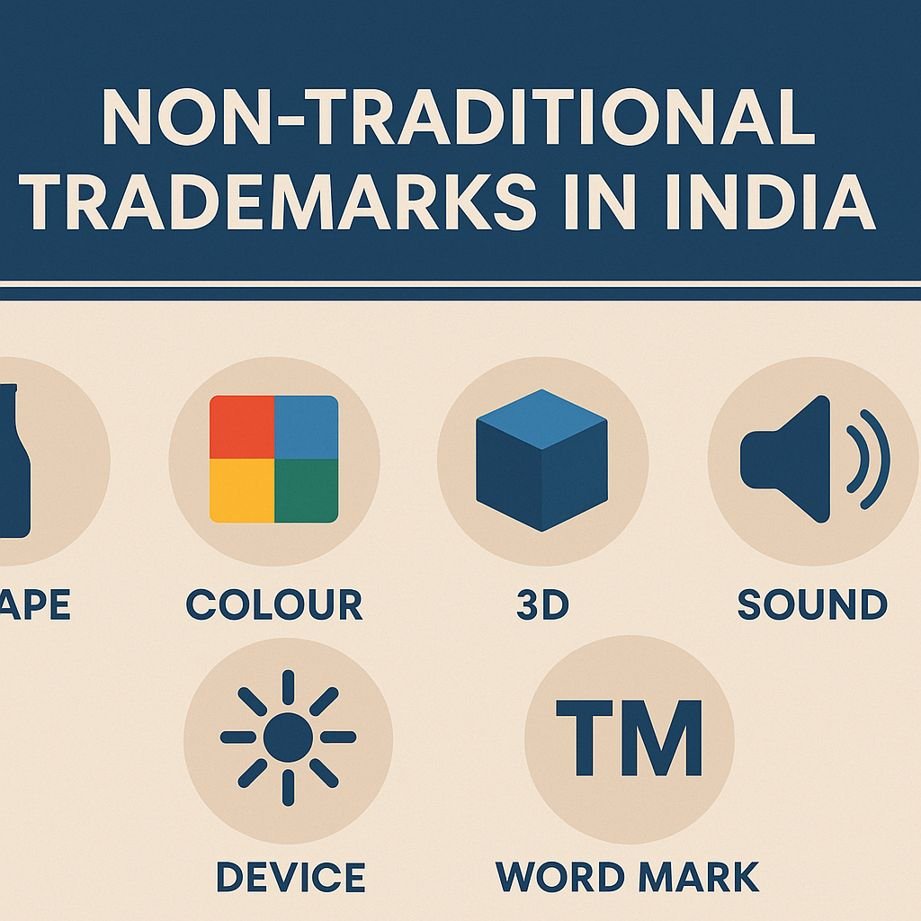Table of Contents
ToggleIntroduction
The concept of trademarks has evolved significantly in the past few decades. Traditionally, trademarks consisted of words, names, logos, and symbols that identified the source of goods or services. However, with global trade expanding and branding becoming increasingly sophisticated, companies began seeking protection for non-traditional forms of trademarks such as sounds, colours, shapes, and even smells in some jurisdictions. In India, the Trade Marks Act, 1999, along with the Trade Marks Rules (with important updates in 2017), provides a broad definition of trademarks that goes beyond traditional marks. The statutory framework recognizes that branding today involves much more than simple logos or names — it is about the overall identity and distinctiveness of a product or service.
This article takes a comprehensive look at the recognition, requirements, and case law relating to non-traditional trademarks in India. It explores their registration requirements, challenges, case studies, and comparisons with global practices. For businesses and legal practitioners, understanding these categories is essential, given that modern consumers often identify products and services through unique jingles, packaging designs, or distinctive colour schemes.
Understanding Non-Traditional Trademarks
Under Section 2(1)(zb) of the Trade Marks Act, 1999, a “trade mark” includes any mark capable of being represented graphically and distinguishing the goods or services of one person from those of others. This definition explicitly encompasses shapes, packaging, combinations of colours, and other distinctive identifiers. The Trade Marks Rules, 2017, further clarified procedures — for example, sound marks can be filed using an MP3 recording accompanied by graphical representation such as musical notation or spectrograms.
Key Principles: 1. Distinctiveness — The mark should identify the source. Distinctiveness may be inherent or acquired through use.
- Non-functionality — Marks cannot protect features that are essential for technical functions, or provide a substantial advantage unrelated to brand identity.
- Representation — The mark must be clearly defined graphically or digitally (in the case of sounds).
Categories of Non-Traditional Trademarks in India
1. Word Marks
Although traditional, word marks form the foundation of branding. They are included in discussions of non-traditional marks because words are often paired with shape, sound, or colour elements. For example, a company name might be integrated into unique 3D packaging or combined with a jingle.
2. Device/Logo Marks
Logos, stylized depictions, or pictorial elements often combine with other identifiers such as colour or shape. They form an important bridge between traditional and non-traditional marks, as they may incorporate unusual fonts, symbols, or artistic designs.
3. Shape / 3D Marks
Shapes or three-dimensional forms include product configurations and packaging designs. For example, the contour of a Coca-Cola bottle is globally recognized. However, in India, registrability requires that the shape not be generic or functional and that it has acquired secondary meaning.
Challenges: – Consumers may not inherently perceive shape as an indicator of origin. – Examiners often require strong evidence that consumers associate the shape with a particular brand. – Section 9(3) of the Trade Marks Act restricts registration of shapes arising from the nature of goods, those necessary to achieve a technical result, or shapes that add substantial value.
4. Colour Marks
Colours or combinations of colours can be registered, but only when they clearly identify a source. The Indian Registry demands exact descriptions using internationally recognized systems such as Pantone. Courts are skeptical of vague claims like “predominant purple.”
Examples: – Cadbury’s attempt to protect purple packaging worldwide illustrates the challenges. Even where successful, evidence of consumer association and long-standing use is critical. – Functional colours, such as those used in safety equipment (orange, yellow), are generally refused.
5. Sound Marks
India began formally accepting sound marks after the 2017 Rules. These marks cover musical notes, jingles, tones, and unique sounds associated with a brand.
Requirements: – Submission of an MP3 file not exceeding 30 seconds. – A graphical representation (musical notation, spectrogram, or descriptive explanation). – Proof that the sound is distinctive and associated with the applicant.
Successful examples in India include Yahoo!’s Yodel, ICICI Bank’s corporate jingle, Nokia’s startup tone, and Netflix’s “Ta-dum.”
Registration Requirements in India
The Indian Trade Marks Registry applies strict standards while examining non-traditional marks:
- Distinctiveness:
- Inherent distinctiveness is rare for shapes and colours.
- Applicants often need to show acquired distinctiveness via surveys, sales data, advertising, and consumer recognition.
- Non-Functionality:
- Functional aspects cannot be monopolized.
- For shapes, the feature cannot arise from the nature of the goods or provide technical advantage.
- Representation:
- Marks must be represented graphically or digitally with precision.
- Colour marks require Pantone codes; sound marks require notation and audio files.
Landmark Indian Case Studies
- **Knitpro International v. Examiner of Trade Marks (Delhi High Court)**The company sought registration of a knitting needle shape. The application was rejected for lack of distinctiveness. On appeal, the Delhi High Court emphasized: – Shape marks must acquire secondary meaning. – Section 9(3) prohibits registration of functional or generic shapes. – Distinctiveness must be strong enough for consumers to identify the product source solely from its shape.
- **Yahoo! Yodel Sound Mark (2008)**Yahoo! successfully registered its Yodel, making it the first sound mark in India. The application included musical notation, satisfying the graphical requirement. The Registry recognized its distinctiveness based on global reputation and local recognition.
- **ICICI Bank Jingle (2011)**ICICI registered its jingle “Dhin Chik Dhin Chik” as a sound mark. The Registry accepted musical notation plus evidence of widespread advertising to prove distinctiveness. This case demonstrated that Indian companies, not just global players, can successfully register sound marks.
- **Carlsberg Breweries v. Som Distilleries (Delhi High Court)**The court held that Som’s imitation of Carlsberg’s bottle shape and packaging amounted to infringement, highlighting judicial recognition of shape-based trade dress.
- **Gorbatschow Vodka v. John Distilleries (Bombay High Court)**The court acknowledged that Gorbatschow’s vodka bottle shape was distinctive enough to merit protection, reinforcing the enforceability of shape marks.
Global Comparison
- European Union & UK: The EUIPO and UKIPO permit registration of shape, sound, and colour marks but enforce strict requirements. The Cadbury litigation and Coca-Cola bottle cases illustrate the high burden of proof.
- United States: The USPTO allows non-traditional marks but requires specimens of use and strong evidence of acquired distinctiveness under Section 2(f). The doctrine of functionality is strongly enforced.
- India: While Indian law is broad, the Registry and courts take a cautious approach. Evidence-heavy filings and precise claims are necessary for success.
Practical Tips for Practitioners
- Drafting: Provide precise and detailed representations (Pantone codes, notation, multiple product views).
- Evidence Preparation: Collect consumer surveys, advertising expenditures, media coverage, and sales figures.
- Pre-Filing Search: Check existing marks to avoid conflicts.
- Responding to Objections: Be prepared with legal arguments and evidence against objections based on functionality or distinctiveness.
- Opposition Defense: Expect challenges from competitors and prepare robust counterarguments.
Challenges with Non-Traditional Marks in India
- Shapes: Difficult to prove distinctiveness without long and exclusive use.
- Colours: High risk of rejection if the colour is common or functional.
- Sounds: Success depends on brevity, distinctiveness, and consistent branding use.
- Procedural Complexity: Applicants must ensure compliance with graphical/audio representation rules.
Conclusion
India’s recognition of non-traditional trademarks reflects its alignment with global trends in intellectual property law. However, while the statutory framework is expansive, practical hurdles remain. Shape and colour marks face significant scrutiny and often require substantial evidence of acquired distinctiveness. Sound marks, on the other hand, have shown practical success and may continue to gain traction in branding strategies.
For businesses, protecting non-traditional trademarks is a valuable tool in building brand identity. Yet, success requires careful planning, precise claim drafting, and strong evidence of market recognition. In India, as in other jurisdictions, the future of trademark law lies in balancing the protection of innovative branding strategies with preventing monopolization of functional or generic product features.










